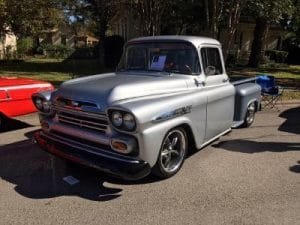Featured here is a very good looking 1959 Chevy Apache 3100 Half Ton. This would be the last year for the Task Force Series Chevrolet Apache. While there were very few changes to the light trucks during the Task Force Series run, the Task Force styling was very different from the Advance Design Series before them.

Chevy’s Task Force Series
The 1959 Chevy Apache 3100 Half Ton was a part of the Task Force Series for Chevrolet which ran from late 1955 through the 1959 model year. The Task Force Series was also known as the Blue Chip Series.
The Task Force Chevy light trucks replaced the Advance Design models which came out after the war in 1947.
Of significance to truck styling is that after WW II passenger car styling became a factor when designing light duty trucks. More emphasis was placed on passenger comfort and passenger car styling. Automakers wanted their trucks to look better.
Chevrolet actually had three different names for their Task Force Series trucks. The light trucks such as the half ton featured here were all called Apaches. Medium duty trucks were named Viking and the heavy duty Chevy trucks were named Spartan.
The Chevy Stepside and Fleetside Styling

The Fleetside styling, which was introduced in 1958 and was considered at the time a fashion-conscious model, is today the ‘standard’ pickup bed style at General Motors, Dodge and most truck brands. The outside wall of the bed is flat while the wheel well arches are contained within the bed itself. This is entirely different from the Stepside styling that Chevy offered where the wheel wells are on the outside of the cargo bed.
Ford uses the name Flareside for the wheel well style outside the cargo bed. Ford also uses the name Styleside for the same flat rear quarter panel styling for their light trucks. This is the same as Chevy’s Fleetside, just different manufacturers.
1959 Chevy Apache 3100 Specifications
Chevrolet Task Force light truck engines included a 238 cubic inch Straight Six, a 265 cubic inch V8, and the 283 cubic inch V8.
The base transmission for the Task Force Series trucks was a three speed manual. There were options available which included overdrive, a heavy duty three speed manual, a four speed manual and a GM Hydra-Matic four speed automatic.
Both the two wheel and four wheel drive Chevrolet Task Force trucks Chevrolet had four-wheel drum brakes.Optional were a full air and rugged air hydraulic systems.
Dimensions included a 114.0 inch wheelbase, 183.8 inch overall outside length for shortbed and 191.3 inch outside length for longbed. ,
Related articles on Auto Museum Online are found on the links below…
Reference materials for this article included…Collector Car Market Review…The Complete Chevrolet Book, Petersen’s, 4th Edition..Collectible Cars from the Editors of Consumer Report…Chevrolet Trucks: 100 Years of Building the Future by author Larry Edsall…General Motors Heritage Center.
1959 Chevy Apache Collector Trucks
 Chevrolet has built hardworking, trend setting trucks for over 100 years and are among the most popular collector vehicles. The Task Force Trucks were popular during their run from 1955-1959 and remain so today.
Chevrolet has built hardworking, trend setting trucks for over 100 years and are among the most popular collector vehicles. The Task Force Trucks were popular during their run from 1955-1959 and remain so today.
This series ushered in wraparound windshields, V-8 engines, and 12-volt electrical systems. As mentioned earlier, the Task Force Series Chevy trucks blended in cargo hauling with passenger car amenities. Collector prices for these light trucks from the latter 1950’s have risen significantly.
Task Force Series light trucks can also be rewarding restoration projects. Parts are readily available and the truck itself is not overly complicated.
Current asking prices for a quality restored 1959 Chevy Apache 2100 Shortbed Stepside pickup can range from $40,000-$75,000.
(Article and photos copyright Auto Museum Online)
